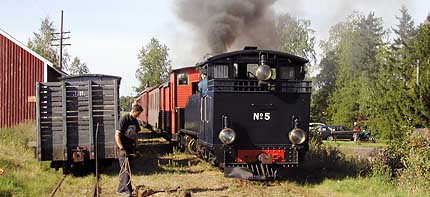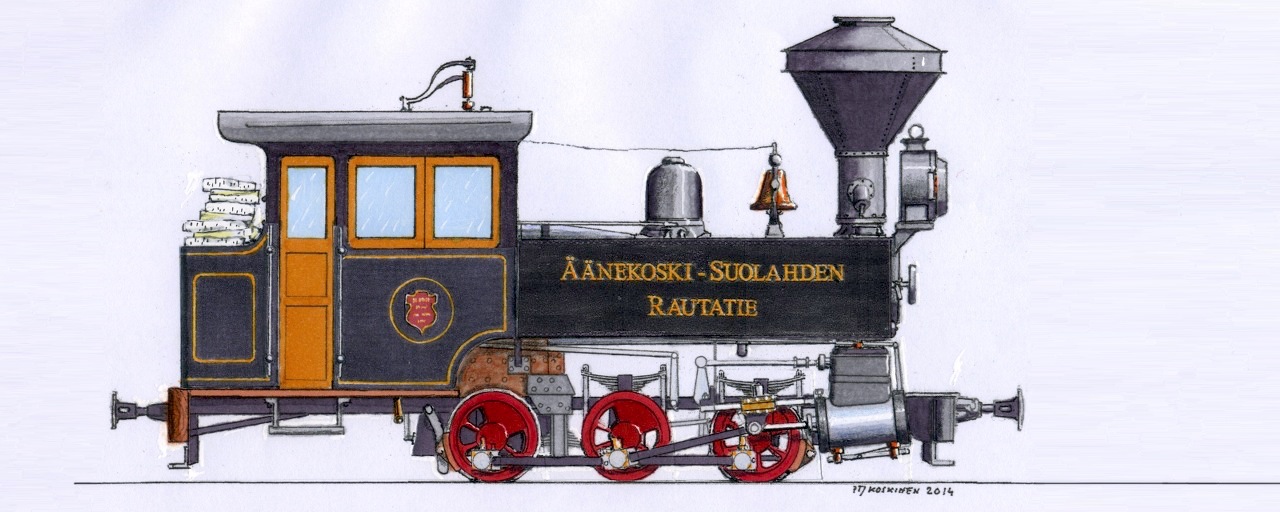Steam locomotives
Jokioinen Museum Railway has five steam locomotives in operation. In addition to that there are five diesel locomotives and a speeder used for track repairs inspection.
Number 6 was running on revenue traffic for 51 years from 1909 until 19 April, 1960. The locomotive was donated to the museum of town of Loviisa and it was placed as a stationary monument in the centre of Loviisa. Museum Railway Association, who is running and maintaining the Jokioinen Museum railway, was able to negotiate a deal where the locomotive was donated to association. On 23 September, 1982 the locomotive was transported to Minkiö to be stored indoors. Later on the locomotive was painted for the narrow gauge museum exhibition. The town of Loviisa donated the locomotive to Museum railway Association in 1996 and the renovation of the locomotive started in autumn 1996. The renovation was mostly financed by the Ministry of Transportation.
In the renovation the locomotive was rebuilt to her 1920s outfit by painting her black instead of dark green, the valve gear was rebuilt to original, the smoke stack was changed, and the acetylene lamps of the locomotive were rebuilt. At the moment number 6 is the only locomotive in Finland with working acetylene lights.

The renovation was made at Jomeco Oy machine shop in Jokioinen. Final steps of the work were completed in spring and summer 1998. The climax of the renovation project was reached on Saturday 15 August, 1988 when the rebuilt locomotive was loaded on a flat bed truck and transported 10 kms to Minkiö station. At Minkiö the locomotive was pulled on tracks and the next day she was moving under her own power for the first time in 40 years!
Number 6 has been pulling the regular museum trains since spring 1999. The Grand Old lady has been showing to be very reliable and good running locomotive.
Technical information
- Weight (with the tender):
- 54 500 kg
- Fuel:
- birch firewood
- Capacity of the tender:
- 8,5 m3
- Capacity of the boiler:
- about 3,3 m3
- Working pressure:
- 10 kg/cm2
- Wheels:
- 2-8-0 (4 driving wheel sets, 1 traversing whilst)
- Lights:
- acetylene gas lamps
Museum train traffic was started in 1971 on the track of Jokioinen railway in 1971 by trains hauled by Hyvinkää-Karkkila railway steam locomotive number 5. The locomotive was made at Tampere Linen and Iron Industry, later Tampella, work shops in Tampere, Finland in 1917. Number 5 is the first locomotive being completed after the independence of Finland.
Number 5 served her working life on 45 km Hyvinkää-Karkkila railway in years 1918-1967. After the railway was closed Kymin Oy became her new owner. In 1969 the locomotive was donated to Veturien Ystävät ry (Friends of Locomotives Association). The locomotive which was in relatively bad shape was transported to Forssa, and renovated to working order by a group of railway enthusiasts in 1969-1971. After that the ownership of the locomotive was transferred to Museum railway Forssa-Humppila which was the predecessor of the present day Museum Railway Association.

Number 5 was used in volunteer operated traffic to haul museum trains on Jokioinen railway between Humppila and Forssa in 1971-1973. After Jokioinen railway was closed part of the line was demolished and the museum traffic could continue only in 1978. In 1979 number 5 was transported to VR Hyvinkää locomotive shops where a two year long renovation was made to her. Later on number 5 has gone through several minor repares.
Technical information
- Weight:
- about 35 000 kg
- Fuel:
- birch firewood
- Working pressure:
- 12 kg/cm2
- Wheels:
- 2-8-2T (4 driving wheel sets, 2 traversing wheel sets)
- Lights:
- paraffin lamps
On the 4th of may 1901 the steamship "Astrella" sailed in Hanko Port in Southernmost tip of Finland. Part of its load was 18 wooden boxes of locomotive parts; a locomotive disassembled in parts and manufactured by H.K. Porter of Pittsburgh Philadelphia in U.S.A. in 1901 carrying a manufacturer number 2313. The boxes were shipped by rail from Hanko to Suolahti and forward to Äänekoski along the newly built 750 mm narrow gauge Äänekoski - Suolahti railway (ÄSR). The locomotive was second locomotive at the ÄSR. The first locomotive was also built by H.K. Porter. When assembled the locomotive got the road number #1, the number of the first but smaller locomotive. The first locomotive was renumbered #2.
A boiler of this Porter locomotive was built for about 20 years life span. It is not known when the original boiler was scrapped. The second boiler was built by Tampereen Pellava- ja Rautateollisuus (Tampella) in Tampere, Finland in 1913. Its use was discontinued 1n 1933, but in 1941 it was taken back in the use when the present boiler, built by Tampella in 1932, was renovated. At this renovation the copper fire-box of the current boiler was replaced by a steel one.
At ÄSR the locomotive was called the Big Ram (Iso Pässi). It was used on the main line traffic until 1st of May 1943 when the traffic on the private narrow gauge railway was discontinued and transferred to new State Railway broad gauge line. After this the locomotive was used in the internal traffic of Äänekoski Paper Mills. This ended in 1964 when the narrow gauge lines were closed. In years 1964-66 the locomotive was used to generate steam at the paper mills. In 1966 its windows were protected by plywood sheets and it was stored outside.

The locomotive was donated to Museum Railway Forssa-Humppila (later the Museum Railway Association) in 1971. Renovation of the locomotive started in 1972 by dismantling it and sand blasting a boiler and some smaller parts. At this moment the boiler was thought to be in such a bad shape that the renovation work was stopped. The renovation work was started again in spring 1989 because parts of the locomotive were around the museum railway and there was a danger that some parts would be lost or damaged.
In 1993 it was agreed with a machine shop in Jokioinen that they would do the renovation of the frame. At the same time the members of the association started collecting information of the locomotive and working on the boiler of the locomotive. When the renovation went on the boiler of the locomotive was found to be in excellent condition. It was cleaned and new tubes were installed. In spring 1996 the boiler passed the water pressure tests. The same year a new smoke stack was made according to the old drawings.
Renovation work of the locomotive was going on always when there was spare time of the more important projects. The first firing up of the locomotive after 39 years was took place on Saturday the 11th of June, 2005. The fire was lit at 9.00 AM and full 12 kg/m2 working pressure was reached early afternoon. The first test drive was performed one week later on Saturday 18th of June, 2005. Officially the locomotive was taken in service during the first Minkiö Steam Festival on Sunday the 31st of July, 2005. On that day the locomotive pulled a special train for invited guests from Minkiö to Jokioinen and back.
Technical information
- Builder:
- H.K. Porter Company, Pittsburgh, U.S.A., 2313/1901
- Weight:
- 13 700 kg
- Fuel:
- birch firewood
- Tractive force:
- 22 kN (2240 kp)
- Wheels:
- 0-6-0T
- Steam engine:
- Piston lenght 356 mm, cylinder diametre 229 mm, saturated steam engine
- Boiler:
- Tampella TK 227/1932, fire surface 20.3 m2, grate surface 0.48 m2, capacity 1.1 m3
Read also

The newest steam locomotive of Jokioinen Museum Railway is a Belgian tank engine built in 1948. Originally the locomotive is used in Jokioinen Railway and it is technically indentical with Jokioinen Railway number 4 "Tubize". In Jokioinen railway it was known as number 5.
The locomotive is named Orion by its former user, Welshpool & Llanfair Light Railway in Wales, Great Britain. The locomotive is built by S.A. Les Ateliers Metallurgiques Nivelles Division de Tubize in Nivelles, Belgium.
JR 5 served in traffic from 1948 to 1964, when it's boiler corrupted and it was stored in Jokioinen in temporary shed made around it. In 1972 Malcolm Knight, a steam enthusiast that worked on steam engines as a draftsman and fitter in his younger years before a long and highly respected career on the railways in the UK bought the locomotive and transported it to Great Britain. Later JR5 was rebuilt back in running condition on Welshpool & Llanfair Light Raiway museum railway. Orion served in WLLR museum traffic a couple of years, but rapidly emerged that JR5 was too big and heavy for such light-constructed railway.
When Jokioinen Museum Railway asked to buy JR5 back its original home railway, the WLLR suddenly agreed. The final contract was made in autumn 2006 and locomotive was transported back to Finland. Orion moved first time in Jokioinen Museum Railway in October 15th 2006 (see video below).
Despite Orion is located in Museum Railway, its owner is a Finnish private person.
Technical information
- Weight:
- 36 000 kg
- Total length:
- 8,9 m
- Total width:
- 2,5 m
- Total height:
- 3,3 m
- Fuel:
- coal
- Working pressure:
- 13 kg/cm2
- Wheels:
- 2-6-2T (3 driving wheel sets, 2 traversing wheel sets)
- Lights:
- electric, 24 V DC, electricity produced with a steam turbine generator.
Read also
Jokioinen railway acquired the number 4 and its sister locomotive number 5, which was sold to Great Britain in 1972, because the newest and most powerful locomotive made by Henschel had to be given to the Soviet Union as a penalty fee for late war reparation payments in 1945. The size and performance of Tubize locomotives are nearly similar to Henschel. The order for the locomotives was placed in 1946 and number 4 arrived in Finland at the end of 1947.
Tubize was used at Jokioinen railway to pull passenger trains until 1951 and heavy freight trains until 1960s. At that time Jokioinen railway bought three Move 21 diesel locomotives from Loviisa-Versijärvi railway and one Move 21 diesel locomotive from Hyvinkää-Karkkila railway. After that Tubize number 4 and number 5 were used less frequently and in secondary jobs. They were acting as spear locomotives for diesels and in winter they were used to run the snow plowing trains.

Tubize number 4 being at that moment the only operable locomotive of the railway pulled the last revenue freight train of Jokioinen railway on March 31, 1974 from Humppila to Forssa.
In the beginning of 1978 Jokioinen Museum Railway bought Tubize number 4 together with the Minkiö-Jokioinen railway line and a big number of narrow gauge rolling stock. After that the locomotive has been pulling museum trains in summer time. Already when the museum train traffic started on June 25, 1978 the locomotive and especially its boiler was in bad shape, thus the locomotive was fully renovated at VR Kuopio locomotive works in 1985-1988.
Technical information
- Weight:
- 36 000 kg
- Total length:
- 8,9 m
- Total width:
- 2,5 m
- Total height:
- 3,3 m
- Fuel:
- coal
- Working pressure:
- 11 kg/cm2
- Wheels:
- 2-6-2T (3 driving wheel sets, 2 traversing wheel sets)
- Lights:
- electric, 24 V DC, electricity produced with a steam turbine generator.






